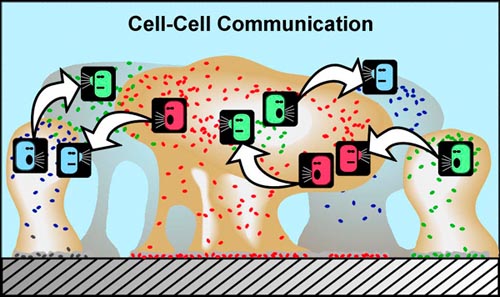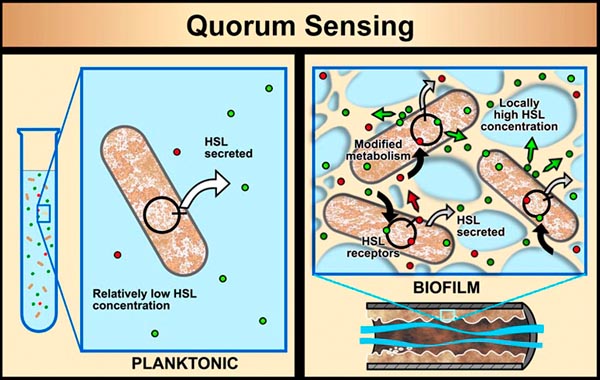Microbes in a Biofilm Can Communicate With Each Other
Another characteristic of cells found in a biofilm is that they can communicate with each other. Really, in order for any community to succeed, there must be good communication among its members. Biofilm communities appear to be no different. Now how, you might ask, can single-cell microorganisms, such as bacteria, communicate with each other? One of the fascinating aspects of bacterial community living is that it provides a setting for bacteria to communicate using chemical signals. There is evidence that some of these chemical signals, produced by cells and passed through their outer membranes, may be interpreted not just by members of the same cell species, but by other microbial species that are part of the same biofilm community — and perhaps even by more complex organisms in some cases. The sensing of these chemical signals by neighboring cells in the biofilm can cause the neighboring cells to behave differently. How? By causing different genetic expression to occur in those cells, as described in the account in subsection 2 above.

In planktonic populations of these same kinds of cells, chemical signals produced by the cells are simply not concentrated enough when passed through the water to cause changes in genetic expression. However, in biofilms, the matrix (glue) material (EPS) that holds cells close together allows concentrations of cell-produced chemical signal molecules to build up in sufficient quantity to cause changes in cellular behavior. Bacterial populations will activate some genes only when they are able to sense, via cell signaling, that their population is numerous enough to make it advantageous and/or "safe" to initiate that genetic activity.
For example, some bacterial pathogens (the bad-guy, disease-causing bacteria) will not produce toxins until they sense that an adequate population of themselves has been established to survive host defenses (e.g., antibodies, produced by a host human or animal, that can kill the bacteria). This system of population recognition has been termed "quorum sensing" (you've got it right; this comes from the same term used in a committee when enough members are present to legally take some action). It was first observed in the marine bacterium Vibrio fischeri, which can produce light after a sufficient population of this bacterium has developed.

The discovery that simple cells are capable of coordinated behavior has given us an entirely, new appreciation of their survival strategies. There is also good evidence that cell signaling can cause cells of the same variety to form sub-populations that carry out different activities. For example, in the late 1990s an investigation of a biofilm community the marine bacterium Pseudoalteromonas revealed two physiologically distinct subpopulations. In effect there was a cellular division of labor: one group stayed attached to the surface and made nutrient available to the the second group, which reproduced and released daughter cells to the surrounding water.
In summary, the life of a simple, single-cell microorganism, such as a bacterium, is not so simple after all! And when these microorganisms are found in a biofilm colony their complexity increases tremendously. In order to treat and/or make beneficial use of biofilms, we must continue to identify and exploit the characteristics that are exhibited by microorganisms that form a biofilm.


